Bathroom leakage and seepage are common issues that can cause significant damage to your home if not addressed promptly. They can lead to mold growth, structural damage, and increased water bills. However, with the right approach, these problems can be turned into an opportunity for home improvement. Here’s how you can tackle bathroom leakage and seepage to enhance your home.
Understanding the Causes
Before diving into solutions, it’s essential to understand the common causes of bathroom leakage and seepage:
- Faulty Plumbing: Leaks often originate from worn-out pipes, faulty seals, or loose connections.
- Damaged Grout and Tiles: Cracked or missing grout and broken tiles can allow water to seep into walls and floors.
- Inadequate Waterproofing: Poor waterproofing during construction can lead to water penetration.
- Clogged Drains: Blockages in drains can cause water to overflow and seep into unwanted areas.
Assessing the Damage
To effectively address the issue, a thorough assessment is necessary. Look for the following signs:
- Visible Water Stains: Brown or yellow stains on ceilings or walls indicate water damage.
- Mold and Mildew: A musty smell or visible mold growth points to ongoing moisture problems.
- Peeling Paint or Wallpaper: These are signs that water is penetrating the walls.
- Loose or Damaged Tiles: Check for loose tiles or grout lines that are crumbling.
Solutions for Bathroom Leakage and Seepage
1. Repairing and Replacing Faulty Plumbing
The first step is to fix any plumbing issues. Hire a professional plumber to inspect and repair or replace any damaged pipes, seals, or connections. Ensure all joints are secure and there are no leaks.
2. Regrouting and Retiling
Damaged grout and tiles are common sources of leaks. Remove the old grout and reapply a high-quality waterproof grout. Replace any broken tiles to create a watertight seal.
3. Improving Waterproofing
If poor waterproofing is the culprit, consider applying a waterproof membrane to the bathroom walls and floors. This will create a barrier that prevents water from seeping through.
4. Installing Proper Ventilation
Proper ventilation helps to reduce moisture levels in the bathroom, preventing mold growth and water damage. Install an exhaust fan or improve existing ventilation to keep the air dry.
5. Regular Maintenance
Prevent future leaks by conducting regular maintenance checks. Inspect the bathroom for signs of wear and tear and address any issues promptly.
Upgrading Your Bathroom
While addressing leakage and seepage, it’s an excellent opportunity to upgrade your bathroom. Here are some home improvement ideas:
1. Upgrade Fixtures
Replacing old fixtures with modern, water-efficient ones can enhance the look of your bathroom and save on water bills. Consider installing a new showerhead, faucets, and a low-flow toilet.
2. Enhance Lighting
Good lighting can transform the ambiance of your bathroom. Add LED lights around the mirror or install a stylish chandelier for a touch of elegance.
3. Install a New Vanity
A new vanity can provide more storage space and update the overall look of your bathroom. Choose a design that complements the existing decor and meets your storage needs.
4. Add a Fresh Coat of Paint
A fresh coat of paint can make a significant difference. Choose moisture-resistant paint in a color that brightens up the space and gives it a clean, fresh feel.
Professional Help
While some tasks can be DIY projects, others require professional expertise. Hiring professionals ensures that the job is done correctly and prevents further damage.
Conclusion
Addressing bathroom leakage and seepage is crucial for maintaining a healthy and attractive home. By understanding the causes, assessing the damage, and implementing the right solutions, you can not only fix these issues but also improve your bathroom’s functionality and aesthetics. If you need expert assistance in dealing with bathroom leakage and seepage, consider Zeko Service. Their professional team can provide comprehensive solutions to ensure your bathroom remains leak-free and beautiful.

